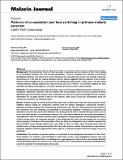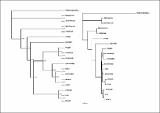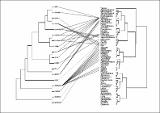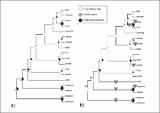Por favor, use este identificador para citar o enlazar a este item:
http://hdl.handle.net/10261/13637COMPARTIR / EXPORTAR:
 SHARE SHARE
 CORE
BASE CORE
BASE
|
|
| Visualizar otros formatos: MARC | Dublin Core | RDF | ORE | MODS | METS | DIDL | DATACITE | |

| Título: | Patterns of co-speciation and host switching in primate malaria parasites |
Autor: | Garamszegi, László Z. CSIC ORCID | Fecha de publicación: | 22-may-2009 | Editor: | BioMed Central | Citación: | Malaria Journal 8:110 (2009) | Resumen: | [Background] The evolutionary history of many parasites is dependent on the evolution of their hosts, leading to an association between host and parasite phylogenies. However, frequent host switches across broad phylogenetic distances may weaken this close evolutionary link, especially when vectors are involved in parasites transmission, as is the case for malaria pathogens. Several studies suggested that the evolution of the primate-infective malaria lineages may be constrained by the phylogenetic relationships of their hosts, and that lateral switches between distantly related hosts may have been occurred. However, no systematic analysis has been quantified the degree of phylogenetic association between primates and their malaria parasites. [Methods] Here phylogenetic approaches have been used to discriminate statistically between events due to co-divergence, duplication, extinction and host switches that can potentially cause historical association between <em>Plasmodium </em>parasites and their primate hosts. A Bayesian reconstruction of parasite phylogeny based on genetic information for six genes served as basis for the analyses, which could account for uncertainties about the evolutionary hypotheses of malaria parasites. [Results] Related lineages of primate-infective Plasmodium tend to infect hosts within the same taxonomic family. Different analyses testing for congruence between host and parasite phylogenies unanimously revealed a significant association between the corresponding evolutionary trees. The most important factor that resulted in this association was host switching, but depending on the parasite phylogeny considered, co-speciation and duplication may have also played some additional role. Sorting seemed to be a relatively infrequent event, and can occur only under extreme co-evolutionary scenarios. The concordance between host and parasite phylogenies is heterogeneous: while the evolution of some malaria pathogens is strongly dependent on the phylogenetic history of their primate hosts, the congruent evolution is less emphasized for other parasite lineages (e.g. for human malaria parasites). Estimation of ancestral states of host use along the phylogenetic tree of parasites revealed that lateral transfers across distantly related hosts were likely to occur in several cases. Parasites cannot infect all available hosts, and they should preferentially infect hosts that provide a similar environment for reproduction. Marginally significant evidence suggested that there might be a consistent variation within host ranges in terms of physiology. [Conclusion] The evolution of primate malarias is constrained by the phylogenetic associations of their hosts. Some parasites can preserve a great flexibility to infect hosts across a large phylogenetic distance, thus host switching can be an important factor in mediating host ranges observed in nature. Due to this inherent flexibility and the potential exposure to various vectors, the emergence of new malaria disease in primates including humans cannot be predicted from the phylogeny of parasites. |
Descripción: | 15 pages, 3 figures, 1 table.-- PMID: 19463162 [PubMed].-- Supporting information (3 additional files) available Open Access at: http://www.malariajournal.com/content/8/1/110/additional/ | Versión del editor: | http://dx.doi.org/10.1186/1475-2875-8-110 | URI: | http://hdl.handle.net/10261/13637 | DOI: | 10.1186/1475-2875-8-110 | ISSN: | 1475-2875 |
| Aparece en las colecciones: | (EBD) Artículos |
Ficheros en este ítem:
| Fichero | Descripción | Tamaño | Formato | |
|---|---|---|---|---|
| Malaria.pdf | Main text | 636,81 kB | Adobe PDF |  Visualizar/Abrir |
| Malaria_S1.pdf | Suppl. file 1 | 25,76 kB | Adobe PDF |  Visualizar/Abrir |
| Malaria_S2.pdf | Suppl. file 2 | 46,64 kB | Adobe PDF |  Visualizar/Abrir |
| Malaria_S3.pdf | Suppl. file 3 | 139,32 kB | Adobe PDF |  Visualizar/Abrir |
CORE Recommender
PubMed Central
Citations
21
checked on 17-abr-2024
SCOPUSTM
Citations
48
checked on 23-abr-2024
WEB OF SCIENCETM
Citations
43
checked on 23-feb-2024
Page view(s)
338
checked on 24-abr-2024
Download(s)
399
checked on 24-abr-2024
Google ScholarTM
Check
Altmetric
Altmetric
Artículos relacionados:
NOTA: Los ítems de Digital.CSIC están protegidos por copyright, con todos los derechos reservados, a menos que se indique lo contrario.
